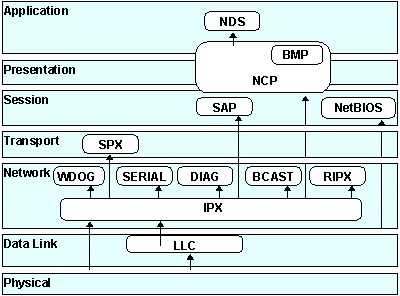NetWare protocols were a suite of network protocols uniquely developed for the Novell NetWare network operating system (NOS), a dominant force in network operating systems during the 1980s and early 1990s. These protocols facilitated robust network communication and resource sharing across diverse operating systems and network architectures. With the evolution of networking technologies and the gradual shift towards more standardized protocols like TCP/IP, NetWare protocols have transitioned into the realm of legacy technology. This article aims to explore the origins, functions, and legacy of NetWare protocols, providing insight into their role in shaping modern networking practices.
Table of Contents:
- What Were the NetWare Protocols?
- The Architectural Design of NetWare Protocols
- Transition from NetWare Protocols to TCP/IP
- Legacy and Impact on Modern Networking
- Preserving Knowledge of Legacy Protocols
- References

1. What Were the NetWare Protocols?
NetWare protocols constituted the foundational networking framework of the Novell NetWare network operating system, which was particularly prominent with NetWare versions 2 and 3. Deriving architectural elements from the Xerox Network Systems (XNS) of the late 1970s, these protocols were engineered to support seamless network communication across a wide range of desktop operating systems including DOS, Windows, Macintosh, OS/2, and UNIX.
Key protocols within this suite included:
- Internetwork Packet Exchange (IPX): A network layer (layer 3) protocol that identifies stations and the networks they reside on and can be used to route packets from one network to another on an IPX internetwork.
- Sequenced Packet Exchange (SPX): A transport layer (layer 4) protocol that provides reliable, connection-oriented communication sessions between hosts on a network.
- NetWare Core Protocol (NCP): An upper-layer (layers 5 and 6) protocol that services requests from applications such as the NetWare shell. NCP supports file and print services, management of network and host names, and accounting and security functions.
- NetBIOS: An upper-layer protocol that provides session-layer interoperability with other NetBIOS-enabled operating systems such as LAN Manager and Microsoft Windows NT.
- Service Advertising Protocol (SAP): Enables NetWare servers to advertise themselves as present on the network and allows clients to find and access resources.

NetWare versions 4 and 5
In addition to these original NetWare protocols, NetWare version 4 also supported Internet Protocol (IP) encapsulation of IPX/SPX packets, which means that IPX datagrams could be encapsulated within User Datagram Protocol (UDP) packets for transmission over TCP/IP internetworks. NetWare 5 had native support for TCP/IP.
NetWare 5 further embraced this shift, offering native TCP/IP support, marking a significant transition towards the modern networking standards we rely on today.
2. The Architectural Design of NetWare Protocols
Influence of Xerox Network Systems (XNS)
The foundational architecture of NetWare protocols was significantly influenced by the Xerox Network Systems (XNS), a pioneering suite of networking protocols developed in the late 1970s. XNS introduced several key concepts in networking, including the idea of a universal network addressing system and the separation of networking functions into distinct layers, principles that profoundly shaped the design of NetWare protocols. Consequently, NetWare adopted a similar layered approach, allowing for efficient packet routing (IPX) and reliable session management (SPX), thereby ensuring robust network communication.
Moreover, the influence of XNS extended to the development of service protocols, such as the Service Advertising Protocol (SAP), enabling NetWare servers to advertise services across the network, a concept reminiscent of XNS’s directory services. This heritage underscored the adaptability and forward-thinking design of NetWare protocols, positioning them as a bridge between early networking paradigms and the emerging needs of diverse computer networks.
Integration with Diverse Desktop Operating Systems
Initially, one of the standout features of NetWare protocols was their comprehensive support for virtually every major desktop operating system available during their heyday, including DOS, Windows, Macintosh, OS/2, and UNIX. This wide-ranging compatibility was instrumental in establishing Novell NetWare as a versatile and inclusive network operating system, capable of seamlessly integrating into heterogeneous computing environments.
By developing customized client software for each supported operating system, NetWare protocols facilitated file sharing, printer access, and other network services across different platforms, thereby breaking down the barriers between distinct computing silos. As a result, businesses could leverage their existing hardware and software investments more effectively, promoting a more unified and collaborative working environment.
3. Transition from NetWare Protocols to TCP/IP
Encapsulation of IPX/SPX over TCP/IP
As the internet and TCP/IP began to dominate the landscape of network communications, NetWare protocols adapted to this changing environment. Starting with NetWare version 4, a significant transition occurred with the introduction of IP encapsulation for IPX/SPX packets. This innovative approach allowed IPX datagrams to be encapsulated within UDP packets, facilitating their transmission over TCP/IP networks. Consequently, NetWare networks could now extend beyond their traditional boundaries, connecting to the broader internet and benefiting from the ubiquity and standardization of TCP/IP.
This encapsulation process not only preserved the operational integrity of existing NetWare networks but also provided a pathway toward greater interoperability and flexibility in network design. Organizations could thus gradually migrate to TCP/IP without disrupting their existing network services, ensuring a smoother transition to the modern networking infrastructure.
Native TCP/IP Support in Later NetWare Versions
By the time NetWare 5 was released, the shift towards TCP/IP was unequivocal. In response, Novell introduced native TCP/IP support, marking a pivotal moment in the evolution of NetWare protocols. This native integration meant that NetWare could directly utilize TCP/IP for all network communications, eliminating the need for IPX/SPX encapsulation and aligning NetWare networks with the global internet standard.
The adoption of native TCP/IP support facilitated easier network management, reduced protocol overhead, and improved performance. It also enhanced NetWare’s compatibility with a wide range of internet services and applications, further solidifying its relevance in an increasingly connected world. Through this transition, NetWare protocols embraced the future of networking, ensuring that NetWare environments remained competitive and capable of meeting the demands of modern network users.
4. Legacy and Impact on Modern Networking
Lessons Learned and Contributions to Networking Standards
The legacy of NetWare protocols extends far beyond their operational lifespan, offering enduring lessons on the design and implementation of network systems. Importantly, the protocols underscored the value of a robust, layered architecture for facilitating efficient and reliable network communication. Furthermore, the transition from proprietary protocols like IPX/SPX to the universally adopted TCP/IP highlighted the critical importance of interoperability and standardization in fostering a globally connected digital world.
Moreover, NetWare’s approach to network services, particularly its early emphasis on directory services and security, significantly influenced subsequent developments in networking standards. These contributions have been instrumental in shaping the functionalities of modern network operating systems and directory services, ensuring that the foundational principles of NetWare protocols continue to resonate within contemporary networking practices.
Transitioning from NetWare Protocols in Contemporary Networks
As networks evolved, the transition from NetWare protocols to TCP/IP became a pivotal movement within the industry. This shift not only aligned with the global standardization of internet protocols but also encouraged the development of more open, scalable, and secure networking solutions. Today, the principles of flexibility, interoperability, and security that characterized NetWare protocols are echoed in the design of modern network infrastructures, ensuring that the legacy of NetWare continues to influence contemporary network management and design.
5. Preserving Knowledge of Legacy Protocols
Importance for Networking Professionals
Understanding legacy protocols like those developed for NetWare is crucial for networking professionals. This knowledge not only offers insights into the historical evolution of network technologies but also enhances troubleshooting skills, particularly in environments where legacy and modern systems coexist. Moreover, studying these protocols fosters a deeper appreciation of current networking paradigms, enabling professionals to innovate and adapt more effectively to future challenges.
Resources and Documentation for Historical Study
To facilitate the preservation and study of NetWare protocols and other legacy networking technologies, several resources and documentation are available:
- Online Archives and Digital Libraries: Many institutions and organizations maintain archives of software, documentation, and technical papers related to legacy networking systems.
- Networking Textbooks and Manuals: Books that cover the history and development of networking often provide detailed discussions of legacy protocols and their impact.
- Professional Development Courses: Some courses and workshops focus on the history of networking technologies, offering valuable insights into legacy protocols.
6. References
Books
- “Networking Essentials” by Jeffrey S. Beasley and Piyasat Nilkaew – Offers a comprehensive overview of networking principles, including a historical perspective on legacy protocols.
- “Interconnections: Bridges, Routers, Switches, and Internetworking Protocols” by Radia Perlman – Provides in-depth discussions on networking protocols, including those used in NetWare.
RFCs
- RFC 1795: “Data Link Switching: Switch-to-Switch Protocol” – Although not directly related to NetWare, this RFC offers insights into contemporary protocol development influenced by legacy systems.
- RFC 1132: “Standard for the transmission of 802.2 packets over IPX networks” – Documents an attempt to bridge NetWare protocols with other networking standards, highlighting interoperability efforts.